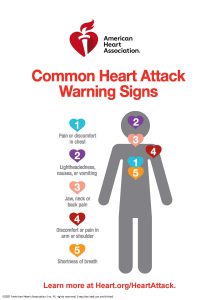Have you ever experienced just feeling “off” or not quite right? Ever said, “I’m fine – really, I’ll be okay”, “I don’t have time to feel bad” or “I just don’t have time to go to the doctor.” Sometimes we get so busy in life, that we don’t pay attention to the warning signs. Please take a moment to listen to Amy’s story here.
“Heart disease is the leading cause of death for men, women, and people of most racial and ethnic groups in the United States.” “Every 40 seconds, someone in the United States has a heart attack” (CDC, 2022). Heart attacks occur when the oxygen rich blood going to the heart is “severely reduced or cut off” (American Heart Association, 2016). Stroke is the 5th leading cause of death and occurs when “a blood vessel that carries oxygen and nutrients to the brain is either blocked by a clot or bursts causing part of the brain to not receive the oxygen it needs and the cells die” (American Heart Association, 2021).
It’s heart health month, and I can’t think of a better time to share the signs and symptoms of a heart attack and stroke from the American Heart Association. Knowing the signs and symptoms may be what saves someone’s life.
Heart Attack Symptoms
- Pain or chest discomfort – often in the center of the chest lasting more than a few minutes. It may include a squeezing or tight feeling in the chest. This is one of the most common symptoms for both women and men.
- Lightheadedness, nausea, or vomiting – cold sweats, too
- Jaw, neck, or back pain – more common in women
- Discomfort or pain in arm or shoulder – the pain can be in either arm or both
- Shortness of breath – more common in women
For more information on heart attacks including warning signs, life after, and ways to reduce risk, click here.
If you’ve already experienced a heart attack, read more on ways to lower your risk of a second heart attack.
Stroke Symptoms
The American Heart Association recommends calling 9-1-1 immediately – do not wait if you see someone experiencing the following symptoms. The acronym F.A.S.T. is used, reminding you to act fast and call emergency services.
F: Face drooping on one side – quick test is to ask the person to smile. If it is uneven, this might be a symptom of a stroke.
A: Arm weakness: one or both arms are weak or numb – quick test is to ask the person to raise both arms. Look for one arm drifting down. If you see this, this may be a symptom of a stroke.
S: Speech: slurred speech – quick test – ask them to say a simple sentence. If they are not able to form words or it is difficult to understand, this could be a symptom of a stroke.
T: Time to call 9-1-1. If you see any of these symptoms, it’s always best to call emergency services and do so fast. Immediate treatment may reduce long term impacts from the stroke and may even prevent death.
Listen to Erica’s story She’s a survivor.
Recognize and listen to the warning signs of a heart attack and stroke – no matter how busy life can get. If you are experiencing symptoms, call 9-1-1.
Read more about heart disease and stroke here.
Adapted from an original post, Wellness with Wendy e-news (February 10, 2021).
Author: Wendy W. Lynch
Banner image credit: Canva.com/Education
 1
1


